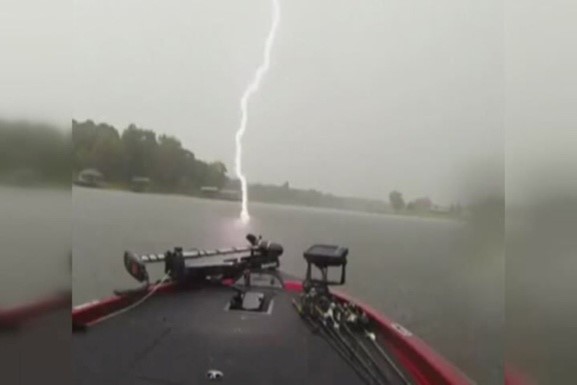By Al Bennett – June 2023
Historically, the number of fatalities in the United States from lightning strikes per year is 51. In the last 10 years and due to advanced warning and more public awareness, the average number of fatalities is 23.  Each year, the National Weather Service publishes a list of people that have died because of lightning and that list includes people that have died while boating, jet skiing, swimming, and fishing.
Each year, the National Weather Service publishes a list of people that have died because of lightning and that list includes people that have died while boating, jet skiing, swimming, and fishing.
Unfortunately, a lightning strike recently caused fatalities on Lake Anna. This tragic incident involved a family of eight who were cruising the lake on a pontoon boat. They found themselves caught out on the water while a severe thunderstorm was passing through our area. A bolt of lightning struck their pontoon boat, killing two family members.
The remainder of this article is meant to increase everyone’s knowledge and awareness of the danger thunderstorms present. First, a few facts about thunderstorms and lightning, published by the National Weather Service and Arizona State University:
- The average thunderstorm is 6-10 miles wide.
- The average thunderstorm travels at a rate of 25 mph.
- It is not possible to have thunder without lightning. Thunder is a direct result of lightning.
- Lightning can have 100 million to 1 billion volts, 10,000 to 200,000 amps, and contain billions of watts.
- Energy from lightning heats the air anywhere from 18,000 degrees Fahrenheit to up to 60,000 degrees Fahrenheit. Note, the temperature at the surface of our sun is about 10,000 degrees.
- The average lightning strike is 6 miles long.
To see a short video clip of lighting hitting a docked sailboat, go to https://www.youtube.com/watch?v=lgaRtqKGNKk or search YouTube for Sparks Fly as Lightning Hits Sailboat in Boston Harbor. The lightning strike occurs within the first 10 seconds of the video and it is a very strong visual to remind us that we do not want to be on a boat that is stuck by lightning.
You can estimate how many miles you are from a lightning strike by using the flash-to-bang method. After seeing a flash of lightning, count the number of seconds until you hear the associated thunderclap and divide that number by five. This method will give you a good approximation of how many miles you are away from the lightning. For example, if five seconds have elapsed, you are one mile away. Similarly, if 25 seconds have elapsed from flash to bang, then you are 5 miles away.
Do not put yourself, family, and/or friends at risk. To prevent being caught in a thunderstorm, you should apply the National Oceanic and Atmospheric Administration’s (NOAA’s) 30/30 Lightning Safety Rule: Go indoors if, after seeing lightning, you cannot count to 30 before hearing thunder. Stay indoors for 30 minutes after hearing the last clap of thunder. Based on the flash-to-bang method and not being able to count to 30 after seeing a strike and not hearing thunder, lightning is occurring less than six miles away. You are now well within the range of a lightning bolt of average length. If this condition exists, you should immediately cease water sports activities and seek shelter.
alan.bennett@lakeannavirginia.org
